Women's Suffrage at the West Virginia State Capital
Introduction
Text-to-speech Audio
West Virginia’s 1863 state constitution limited the vote to white men (African American men were given the vote with the 15th Amendment, but WV laws largely prevented them from voting). In 1867, state senator Samuel Young attempted to introduce a resolution in favor of women’s suffrage, but it failed. The West Virginia women’s suffrage movement formalized in 1895 with the organization of the West Virginia Equal Suffrage Association (WVESA). The work of the WVESA in tandem with the Women’s Christian Temperance Union created enough support that the House of Delegates passed a women’s suffrage amendment in 1913. It failed to pass the Senate, but when introduced again in 1915 the amendment was passed by both houses of the state legislature. The amendment then went to a statewide referendum in 1916 where it was soundly defeated.
Images
Carte de visite portrait of Samuel Young, c. 1870.
.jpg)
"West Virginia Legislature: Regular Session." The Wheeling Daily Intelligencer, February 9, 1869.
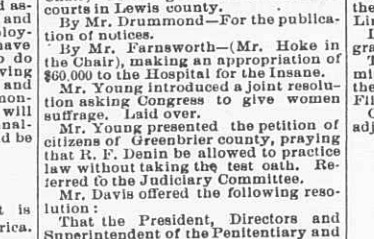
"Pages 134 and 135 from the Journal of the West Virginia Senate in 1867. Samuel Young's resolution to strike the word "male" from Section 1, Article 3 of the West Virginia Consitution appears on page 135."
.jpg)
Harvey W. Harmer, c. 1890.
.jpg)
"Pages 210-211 of the Journal of the West Virginia House of Delegates. Harvey Harmer's resolution to amend the West Virginia Constitution include woman suffrage appears on page 211."
.jpg)
The Wheeling Daily Intelligencer, February 7, 1899.
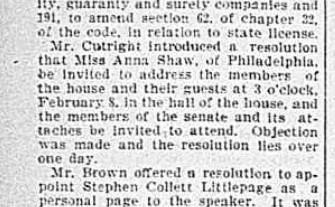
National suffrage leader Dr. Anna Howard Shaw addressed the WV Legislature several times.
.jpg)
The Wheeling Daily Intelligencer, February 16, 1900.
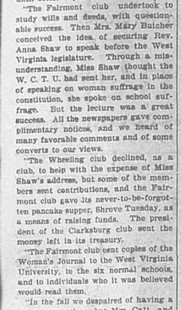
First page of suffrage section of The Wheeling Intelligencer, May 1, 1916
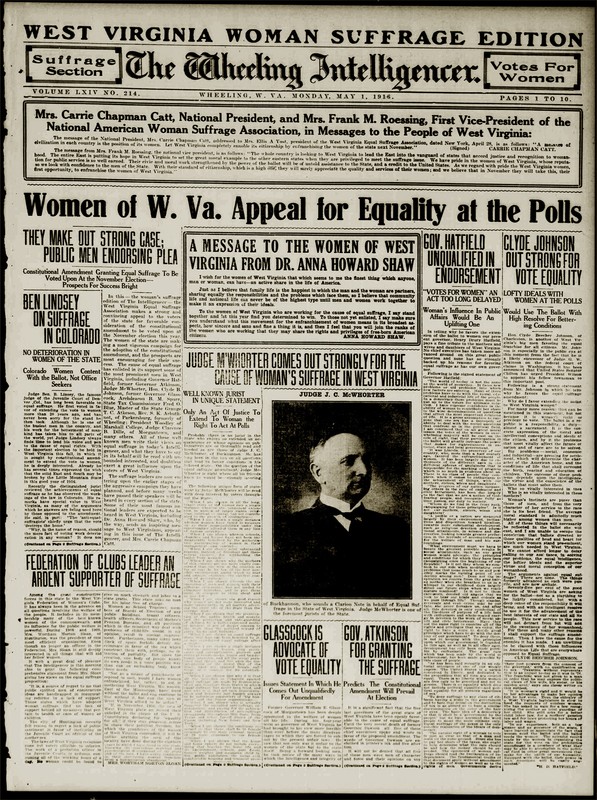
True Democracy. Leaflet issued by the West Virginia Equal Suffrage Association, 1916. L.E. Lantz Collection, West Virginia State Archives.
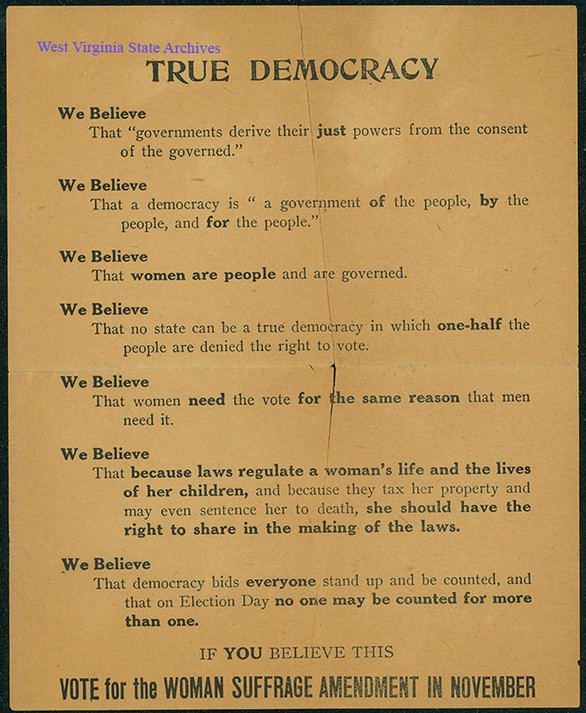
Plain Facts for the Working Man. Leaflet issued by the West Virginia Equal Suffrage Association, 1916. L.E. Lantz Collection, West Virginia State Archives.
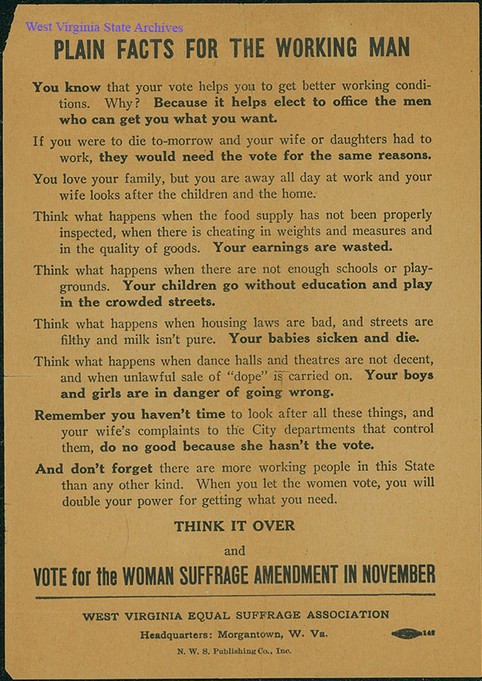
Upshur Record, October 19, 1916
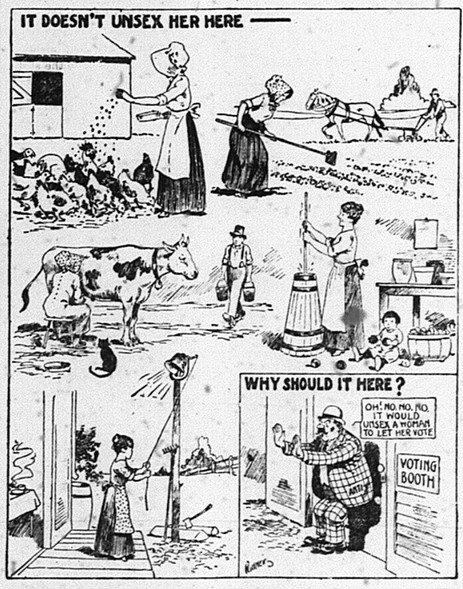
Pro-suffrage advertisement, Shepherdstown Register, November 2, 1916
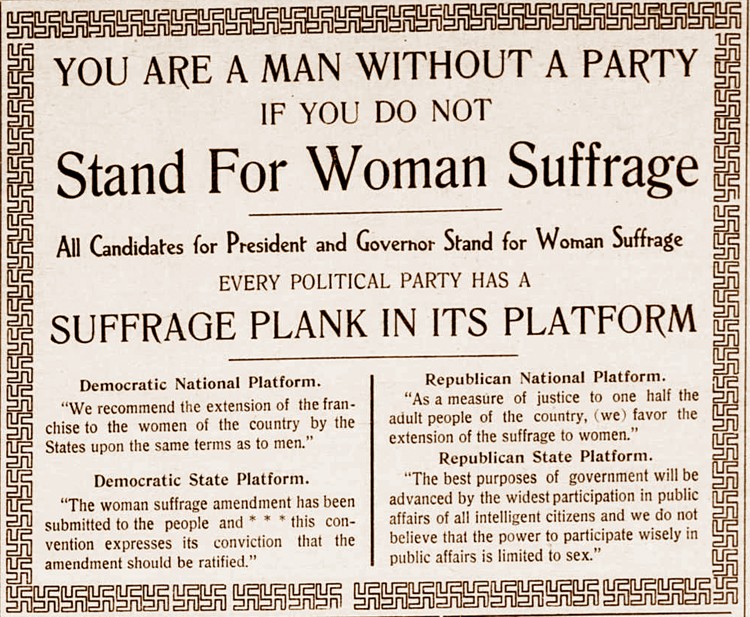
Anti-suffrage advertisement, Huntington Advertiser, November 4, 1916
.jpg)
Report written by Lenna Lowe Yost for the WV Equal Suffrage Association. Yost describes the referendum efforts in the state and pronounces that a good foundation was created for a future suffrage campaign.
.jpg)
West Virginia Equal Suffrage Association Annual Report 1916, page 2
.jpg)
Backstory and Context
Text-to-speech Audio
First attempts:
While the national women’s rights movement began in the 1840s with the Seneca Falls convention, the Civil War interrupted the movement. A new phase of the movement began in 1867 when Kansas held a referendum to write women’s suffrage into the state convention. In addition, in response to the 14th and 15th Amendments which defined natural born citizenship and secured the right to vote for African American men, suffragists Susan B. Anthony and Elizabeth Cady Stanton organized a national association to push for women’s suffrage.
The movement in West Virginia began in 1867 when state senator Samuel Young representing Pocahontas County introduced a resolution on February 19 for women to vote in the state. At the time, there was little interest in the senate about suffrage and his resolution was not advanced. Young tried again in 1869 when he introduced a second resolution that urged the West Virginia Senate to call on the U.S. Congress to address the question of women’s suffrage. The 1869 resolution read: “That we respectfully recommend that while the Constitution of the United States is being amended, extending the right of suffrage to all men over twenty-one years of age, that the same right be granted, at least, to all women over twenty-one years of age, who can read the ’Declaration of Independence’ intelligibly, write a legible hand and have actually paid tax the year previous to their proposing to vote.” This resolution was defeated in a vote.
After these early attempts by Senator Samuel Young the movement stalled in West Virginia until 1895 when women began organizing suffrage clubs and associations across the state. In January 1895, Harvey Harmer of Harrison County offered a new joint resolution to amend the state constitution to include suffrage for women. The Senate voted down the resolution and the House took no action. However, 1895 was an important year. At that point only two states, one of which was West Virginia, had no women’s suffrage organization. That changed in November 1895 when the National American Woman Suffrage Association organized a speaking tour by Henriette G. Moore and called for a convention at Grafton, WV. This led to the organization of the West Virginia Equal Suffrage Association as well as suffrage clubs in different cities in the state.
Dr. Anna Howard Shaw speaks to the West Virginia State Legislature:
In 1899, the Fairmont Political Equality Club raised money to bring Dr. Anna Howard Shaw to speak before the state legislature. The legislature respected Shaw enough to adjourn session to hear her speak, but there was no serious consideration of women’s suffrage as a result.
Attempted Resolutions:
In 1901 a resolution was introduced into the West Virginia House of Delegates by Henry C. Hervey proposing that a woman suffrage amendment be added to the constitution and considered through a state referendum in 1902. This resolution was reported out of committee without recommendation and defeated by a vote of 31-25. The same resolution was introduced in the West Virginia Senate by Nelson E. Whitaker, but was tabled by U.S. Senator Stephen B. Elkins who came in from Washington, D.C. for the purpose of defeating the resolution. At this point West Virginia women were not very active in lobbying to support the resolution and the movement was not very active. By 1902 only one suffrage association was active in the state (the Fairmont Political Equality Club). It would be a couple more years before women started to actively campaign in politics for the right to vote in West Virginia.
In 1905 the state suffrage movement restarted and women became more active in both lobbying the state legislature for the vote and campaigning for suffrage in revised city charters. In 1905 three resolutions on women’s suffrage were introduced in the West Virginia state legislature—two in the House of Delegates and one in the Senate. None of these resolutions got to a vote in their respective chambers.
More resolutions introduced in 1907 by Delegate A. J. Mitchell of Wirt County were also tabled. A 1908 special session saw new suffrage resolutions introduced that this time made through all three required readings in both chambers to go to a vote. With support from Senator Robert Hazlett, Dr. Anna Howard Shaw and Dr. Harriet Jones were able to address the legislature on February 12. During the vote there was a majority of positive votes, but not enough to reach a 2/3 majority to move the resolutions forward.
Another suffrage amendment was introduced into the House of Delegate in 1909 that received no consideration. That same year, another amendment allowing women to hold selected political positions did pass a vote in both the House and Senate, and went to a public referendum. The amendment was narrowly defeated in the 1910 public vote.
Representative Ellis A. Yost of Morgantown, husband of suffrage leader Lenna Lowe Yost, tried again in 1913 by introducing a woman suffrage amendment into the House. The amendment passed the House by a vote of 58 to 25 with little opposition. However, heavy opposition in the Senate blocked it. Opposition senators attempted to amend the amendment to limit potential voting rights and in the vote there was no 2/3 majority vote to pass the amendment on to a public referendum.
1916 Referendum:
West Virginia suffrage leaders finally saw some success in 1915-1916 at the state level. Pro-suffrage governor Henry D. Hatfield opened the 1915 legislative session with a call to put the issue of women’s suffrage through to a referendum vote. Identical bills were introduced into the House and Senate. Michael K. Duty of Ritchie County introduced it in the House as House Joint Resolution No. 1 and N. G. Keim of Randolph County introduced it in the Senate as Senate Joint Resolution No. 5. Unlike earlier attempts where women were less involved in lobbying to the success of legislation, petitions with thousands of signatures flooded in to both chambers supporting (and some opposing) women’s suffrage.
Within three days of the bills’ introduction into the House and Senate the resolution was passed out of committee with a positive recommendation and within a week the bill had passed through the first two required readings. The bill passed through both chambers very quickly, but the Senate did their final reading and vote first. The Senate held its third reading of the bill and voted on January 26, 1915. The vote was overwhelmingly positive, with 28 votes in favor of the bill, one negative vote (R. Dennis Steed of Lincoln County), and one absent member. Once the Senate vote occurred the House dropped their version of the bill (since they were identical) and voted on the Senate resolution. The House voted to concur with the Senate resolution in two days (the minimum required for the readings and vote) and voted in favor 77 to 6. Overall the issue of women’s suffrage took only 9 days from introduction to being passed through to a public referendum.
The public referendum on women’s suffrage was set for November 1916 and West Virginia suffragist leaders geared up to increase support in the state. The 1915 meeting of the West Virginia Equal Suffrage Association in Huntington, WV was the kickoff of the referendum campaign, and the women held the first suffrage parade in the state. While there was statewide approval for women to get the vote, there was also opposition and victory at the polls was not certain. There was a new flurry of suffrage activity and the National American Woman Suffrage Association sent assistance for the campaign. Several speakers from both inside and outside of the state conducted speaking tours through West Virginia to educate voters on the issue and encourage men to vote in favor of suffrage. These speakers included Mary E. Craigie (NAWSA chairman of church work), Deborah Knox (head of Franchise Department of Nation Women’s Christian Temperance Union), Harriet Taylor Upton and Elizabeth J. Hauser of Ohio, and Madeleine McDowell Breckenridge of Kentucky. Anna Howard Shaw addressed state leaders more than ten times and Katherine Devereux Blake spoke for several weeks to Teacher’s Institutes. The NAWSA also sent a “Kampaign Kit” in May 1915 to help West Virginia suffrage clubs organize and prepare for the referendum. In early 1916 Ida Craft of New York led a suffrage school in Charleston to educate voters on women’s suffrage and assist local women in the campaign.
Within West Virginia, Dr. Harriet B. Jones of Wheeling organized many of these speaking tours and sent questionnaires out to 150 newspaper editors to gauge support for the cause. A group of 10 men and women who traveled the state speaking at dozens of locations was known as the “Flying Squadron.” Lenna Lowe Yost of Morgantown took over the presidency of the West Virginia Equal Suffrage Association to combine the power of the suffrage organization and the Women’s Christian Temperance Union, of which she was also president. This was an important strategy for suffragists in West Virginia which was more rural and pro-temperance. Yost ran the referendum campaign from her home in Morgantown. The campaign’s “literature department” also operated from Morgantown under Mrs. P. McBee and Lillie Hagans. They mailed literature to voters, including 200,000 copies of Congressional speeches on suffrage, and sent out 10,000 posters for use on election day. To help with costs the WVESA organized a “dollar day” in October 1915 where suffragists and allies were to earn or give a dollar to donate to the suffrage campaign.
The NAWSA sent additional help in 1916. Four paid outside organizers came into West Virginia to help with the campaign—one paid by the WVESA, two paid for by the NAWSA, and one paid by a gift from the Allegheny County (PA) suffrage association. Hannah Patterson, NAWSA Chairman of Organization, came in March 1916 and she set up a system to spread organizers across the state to supervise the campaign in 5-6 counties with a national officer coming each month to assist. The NAWSA also sent Rose L. Geyer from Iowa to help advise the publicity department in September 1916 (she had led the publicity for the Iowa referendum). Suffrage leaders also sought support from both political parties and organization such as the State Labor Federation.
On the other side, there was organized opposition from women in the state such as anti-suffrage clubs in Huntington and Wheeling and the West Virginia Association Opposed to Woman Suffrage based in Charleston.
Going into the November 1916 referendum most organizers were reasonably confident that the vote would be in favor for women’s suffrage. However, the November 7, 1916 (all male) vote was a landslide defeat for the activists. The vote was 161,607 to 63,540, or 75% against women’s suffrage. While victory had not been guaranteed, nobody expected a defeat this severe. For a period in late 1916 through 1917, the West Virginia movement slowed down. This was partially due to the disastrous defeat in the 1916 referendum and partially due to women engaging in war work as the United States entered World War I. By early 1918 many of the suffrage organizations that had been active during the referendum campaign were no longer meeting. However, in 1918 the U.S. Congress again considered the Susan B. Anthony Amendment (what would become the 19th Amendment) and interest surged again. Once Congress passed the 19th Amendment in May 1919, West Virginia women rallied again to support ratification.
Sources
Effland, Anne Wallace. “The Woman Suffrage Movement in West Virginia, 1867-1920.” M. A. Thesis, West Virginia University, 1983.
Fighting the Long Fight: West Virginia Women and the Right to Vote. A West Virginia Archives and History Online Exhibit. Accessed February 22, 2022. http://archive.wvculture.org/history/exhibitsonline/suffrage/suffrageintroductiontoc.html
"Samuel Young." Women's Suffrage in West Virginia. Accessed February 22, 2022. https://wvsuffrage.lib.wvu.edu/home/s/WV-womens-suffrage/item/849.
The Wheeling daily intelligencer. [volume], February 09, 1869, Image 1. Chronicling America. Accessed February 23, 2022. https://chroniclingamerica.loc.gov/lccn/sn84026844/1869-02-09/ed-1/seq-1/#date1=1867&sort=relevance&rows=20&words=Samuel+Young&searchType=basic&sequence=0&index=8&state=West+Virginia&date2=1869&proxtext=Samuel+Young&y=12&x=11&dateFilterType=yearRange&page=2.
"Journal of the Senate Excerpt." Women's Suffrage in West Virginia. Accessed February 22, 2022. https://wvsuffrage.lib.wvu.edu/home/s/WV-womens-suffrage/item/813.
"Harvey W. Harmer." Women's Suffrage in West Virginia. Accessed February 22, 2022. https://wvsuffrage.lib.wvu.edu/home/s/WV-womens-suffrage/item/773.
"Journal of the House of Delegates Excerpt." Women's Suffrage in West Virginia. Accessed February 22, 2022. https://wvsuffrage.lib.wvu.edu/home/s/WV-womens-suffrage/item/807.
The Wheeling daily intelligencer. [volume], February 07, 1899, Page 6, Image 6. Chronicling America. Accessed February 23, 2022. https://chroniclingamerica.loc.gov/lccn/sn84026844/1899-02-07/ed-1/seq-6/#date1=1899&index=0&rows=20&words=Anna+Shaw&searchType=basic&sequence=0&state=West+Virginia&date2=1899&proxtext=Anna+Shaw&y=11&x=18&dateFilterType=yearRange&page=1.
"Anna Howard Shaw." Wikipedia. Accessed February 22, 2022. https://en.wikipedia.org/wiki/Anna_Howard_Shaw.
The Wheeling daily intelligencer. [volume], February 16, 1900, Page 7, Image 7. Chronicling America. Accessed February 23, 2022. https://chroniclingamerica.loc.gov/lccn/sn84026844/1900-02-16/ed-1/seq-7/#date1=1899&index=6&rows=20&words=Anna+Shaw&searchType=basic&sequence=0&state=West+Virginia&date2=1900&proxtext=Anna+Shaw&y=0&x=0&dateFilterType=yearRange&page=1.
"First page of suffrage section of The Wheeling Intelligencer, May 1, 1916." Fighting the Long Fight: West Virginia Women and the Right to Vote. A West Virginia Archives & History Online Exhibit. Accessed February 22, 2022. http://archive.wvculture.org/history/exhibitsonline/suffrage/suffrage23.html.
"True Democracy. Leaflet issued by the West Virginia Equal Suffrage Association, 1916. L.E. Lantz Collection, West Virginia State Archives." Fighting the Long Fight: West Virginia Women and the Right to Vote. A West Virginia Archives & History Online Exhibit. Accessed February 22, 2022. http://archive.wvculture.org/history/exhibitsonline/suffrage/suffrage37.html.
"Plain Facts for the Working Man. Leaflet issued by the West Virginia Equal Suffrage Association, 1916. L.E. Lantz Collection, West Virginia State Archives." Fighting the Long Fight: West Virginia Women and the Right to Vote. A West Virginia Archives & History Online Exhibit. Accessed February 22, 2022. http://archive.wvculture.org/history/exhibitsonline/suffrage/suffrage36.html
"Upshur Record, October 19, 1916." Fighting the Long Fight: West Virginia Women and the Right to Vote. A West Virginia Archives & History Online Exhibit. Accessed February 22, 2022. http://archive.wvculture.org/history/exhibitsonline/suffrage/suffrage29.html.
"Pro-suffrage advertisement, Shepherdstown Register, November 2, 1916." Fighting the Long Fight: West Virginia Women and the Right to Vote. A West Virginia Archives and History Online Exhibit. Accessed February 23, 2022. http://archive.wvculture.org/history/exhibitsonline/suffrage/suffrage33.html.
"Anti-suffrage advertisement, Huntington Advertiser, November 4, 1916." Fighting the Long Fight: West Virginia Women and the Right to Vote. A West Virginia Archives and History Online Exhibit. Accessed February 23, 2022. http://archive.wvculture.org/history/exhibitsonline/suffrage/suffrage34.html.
"West Virginia Equal Suffrage Association Annual Report 1916." Women's Suffrage in West Virginia. Accessed February 22, 2022. https://wvsuffrage.lib.wvu.edu/home/s/WV-womens-suffrage/item/823.
"West Virginia Equal Suffrage Association Annual Report 1916." Women's Suffrage in West Virginia. Accessed February 22, 2022. https://wvsuffrage.lib.wvu.edu/home/s/WV-womens-suffrage/item/823.
